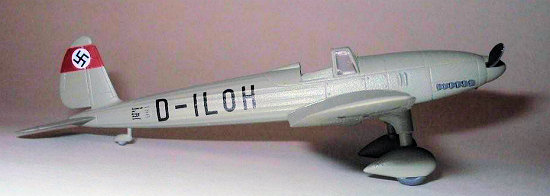
Huma 1/72 Ar-80v2
| KIT #: | ? |
| PRICE: | $ |
| DECALS: | One option |
| REVIEWER: | Brian Baker |
| NOTES: |

| HISTORY |
Designed in 1934 to an RLM
specification that also resulted in the Bf-109, FW-159, and HE-112, the AR-80
prototype began flight testing early in 1935. Powered by a 695 hp. Rolls-Royce
Kestrel engine, the fighter prototype was heavier than anticipated, and its
 performance was unimpressive compared to its competition. The fixed landing gear
probably contributed to this lackluster showing, and only three prototypes were
built, the last being powered by a 640 hp. Junkers Jumo 210C. The final
prototype, V3, was eventually converted into a two-seater with an additional
cockpit, and was used to test advanced, high-lift flaps.
performance was unimpressive compared to its competition. The fixed landing gear
probably contributed to this lackluster showing, and only three prototypes were
built, the last being powered by a 640 hp. Junkers Jumo 210C. The final
prototype, V3, was eventually converted into a two-seater with an additional
cockpit, and was used to test advanced, high-lift flaps.
| THE KIT |
Humaís kit appeared a number of years ago, probably about 2001 or 1002, but there is no indication on the plans or box when it was actually produced. Consisting of 29 injection molded parts, all of which are used, the kit is accurate and well-engineered for easy assembly, going together like a Ďsnap-togetherĒ kit. My example had no flash, and there were no molding irregularities. The instructions consist of two sheets, one giving basic construction details, while the reverse side provides a color three view drawing of the V2 prototype, the one depicted in the kit. The second sheet is a sprue diagram.
| CONSTRUCTION |
 The cockpit interior is, like many
Huma kits, rather Spartan, and if you donít include a pilot figure, then you
will need to add some detail to the interior, especially on the cockpit sides.
The kit provides a floor, seat, stick, instrument panel, and rear bulkhead. The
radiator facing also must be installed before the fuselage halves go together.
The cockpit interior is, like many
Huma kits, rather Spartan, and if you donít include a pilot figure, then you
will need to add some detail to the interior, especially on the cockpit sides.
The kit provides a floor, seat, stick, instrument panel, and rear bulkhead. The
radiator facing also must be installed before the fuselage halves go together.
The wings are cast in one piece, making tedious gluing of wing sections unnecessary. The landing gear struts and wheel pants are a simple three part structure, and the propeller can be assembled and painted before being inserted into the already joined fuselage halves.
| COLORS & MARKINGS |
This is a very easy airplane to
finish. I used a coat of RML 02 grey, and painted the red band for the
swastika, which appears in a white disk in the usual position. The AR-80 V2
carried a civil registration, D-ILOH. The registration of the AR-80 V1 is
unknown, while the Jumo powered third prototype carried D-IPBN in the usual
positions. The V3 prototype would be difficult to convert from
 the V2, since
the engine, wings, and other components were different, and I have yet to see a
photograph of it. Decals are thin and accurate, and no problem to apply, and I
didnít need any Solvaset or other decal solution.
the V2, since
the engine, wings, and other components were different, and I have yet to see a
photograph of it. Decals are thin and accurate, and no problem to apply, and I
didnít need any Solvaset or other decal solution.
| CONCLUSIONS |
This is a good quick-build, and fills a gap in my Luftwaffe collection of 1/72 scale fighters. It is suitable for both experienced and inexperienced modelers, and with only a little effort, a worthy replica of the airplane can be achieved. Get one while these are still available.
| REFERENCES |
Probably the best source of information on this airplane is William Greenís WARPLANES OF THE THIRD REICH. Other information may be found on the internet.
August 2007
Copyright ModelingMadness.com
If you would like your product reviewed fairly and fairly quickly, please contact the editor or see other details in the Note to Contributors.